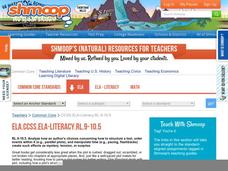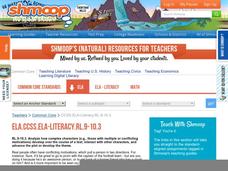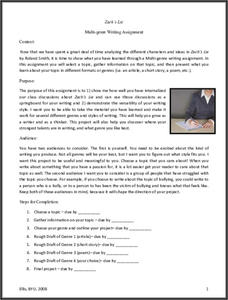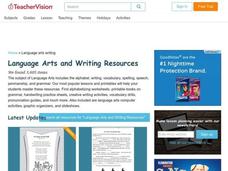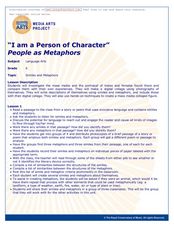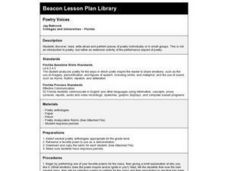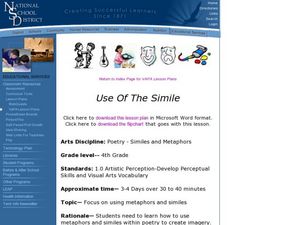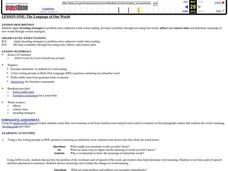Shmoop
ELA.CCSS.ELA-Literacy.RL.9-10.5
Your young scholars already know when they like a story and when they don't, but they may not know that the plots of these stories are shaping that opinion. Like all resources in this series, the two activities and quizzes provided here...
Curated OER
What Is a Euphemism?
In this euphemism worksheet, students study about this writing convention. Students guess what 5 euphemisms mean, then complete some writing and evaluating questions about euphemisms.
Curated OER
Modernism: American Literature 1914-1945
What characterizes modern literature? The first few slides of this 31-slide PowerPoint discuss what sparked the change to Modernism and discuss some of the key figures of the time (like Karl Marx and Sigmund Freud). The 20s and 30s are...
Shmoop
ELA.CCSS.ELA-Literacy.RL.9-10.3
Focus on complex characters with a lesson plan from a series that teaches individual skills from the Common Core. Specifically, this resource provides practice with standard RL.9-10.3. Get pupils thinking and talking about characters...
Novelinks
Zach’s Lie: Multi-Genre Writing Assignment
How do people solve problems in healthy ways? Writers explore a topic of interest in their multi-genre writing assignment exploring Zach's Lie. The final resource in a series of seven includes multiple scaffolds and organizers for...
Curated OER
Using Walt Whitman¿¿¿s Poem ¿¿¿Leaves of Grass¿¿¿ And Takamri¿¿¿s Girl And Boy As Inspiration for Writing a Celebration of Self
Students read and analyze Walt Whitman's poem, "Leaves of Grass." They compare/contrast Whitman's style to artist Takamori's style, and write an original poem about their childhood and fond memories.
Curated OER
I Know Why the Caged Bird Sings
Students read and analyze the novel "I Know Why the Caged Bird Sings" by Maya Angelou. They discuss the poetry and prose of the book, the importance of role models, complete a worksheet, and write a narrative using figurative language.
Curated OER
I Am a Person on Character
Sixth graders explore the portrayal of males and females in mass media. For this language arts lesson, 6th graders create a digital collage and write a description about themselves using similes and metaphors.
Curated OER
Persona Poem
Students write a poem from the perspective of the first-person persona. Through the words of the poem, demonstrate a higher level of thinking by providing insight to the personality of the poem's speaker, the "I" who is featured in the...
Curated OER
Don Quixote
Students examine the use of metaphors in literature. For this literary devices lesson, students read poems that feature extended metaphors and compare them to the metaphors used in Don Quixote. Students then try their hand at writing...
Curated OER
Similes
In this similes worksheet, 4th graders complete the similes and highlight similes in a poem. Students complete 4 activities on this worksheet.
Curated OER
Poetry Voices
Students investigate the performance aspect of poetry by reading, writing and discussing poetry pieces.
Curated OER
Original Line or Familiar Find?
Students examine a primary source document from 1684 that includes many of the same lines found in Romeo's speech to Juliet from Shakespeare's Romeo and Juliet. Students compare the texts and discuss authorship during the sixteenth and...
Curated OER
Personification Stories
Learners create a clay object in which they are to personify. They use their own personal experiences to help the viewer imagine what it would be like to be that particular object. They also watch videos of fables to help them with...
Curated OER
Poetry and PowerPoint
Third graders read and discuss the poem, "April Rain Song" by Langston Hughes. After brainstorming examples of vivid verbs, figures of speech, language patterns, and imagery used in the poem, 3rd graders write a poem on a topic of...
Curated OER
Use of the Simile
Fourth graders identify and write their own similes. In this literary devices instructional activity, 4th graders define and identify similes. The teacher scaffolds the instructional activity so that all students can write their own...
Curated OER
Using Onomatopoeia
Students explore onomatopoeia. They discuss the definition of onomatopoeia. Students brainstorm words that use onomatopoeia and they create a words work to use as a reference for poetry writing.
Curated OER
Literature: Poetic Devices Review
Tenth graders examine poems by Shel Silverstein and identify literary elements in them. The exercise is part of an examination review about poetic elements. The review concludes with students writing nature poems displaying the devices...
Curated OER
Personification
Fifth graders read opening pargraphs in their books and discuss with their peers the meaning of personification. They then identify three instances in the poem "Desert Tortoise" of similarities between humans and animals citing...
Curated OER
The Language of Our World
Students combine prefixes and suffixes to form nonsense words and sentences in the style of Lewis Carroll's "Jabberwocky." In this "Jabberwocky" lesson plan, students brainstorm ways to decode an unfamiliar word and apply these skills...
Curated OER
Similes and Metaphors
In this similes and metaphors worksheet, students write similes for seven given sentences and then change them into metaphors.
Curated OER
Metaphors
In this metaphor worksheet, students make a "word card" with the word metaphor for their vocabulary bank, then determine whether statement from The Dragonslayer are similes or metaphors,
Curated OER
Poetry Book
Students study the following terms and concepts: word choice, dialect, invented words, concrete terms, abstract terms, figurative and sensory language. In cooperative groups, they select three of the terms, research them, and pick poems...
Curated OER
T'was the Night Before Christmas (Poem)
Students read the poem T'was the Night Before Christmas, and then partner with another student to complete a poem of their own based on the original. The new poem has missing words and students fill in the missing parts of speech like a...


